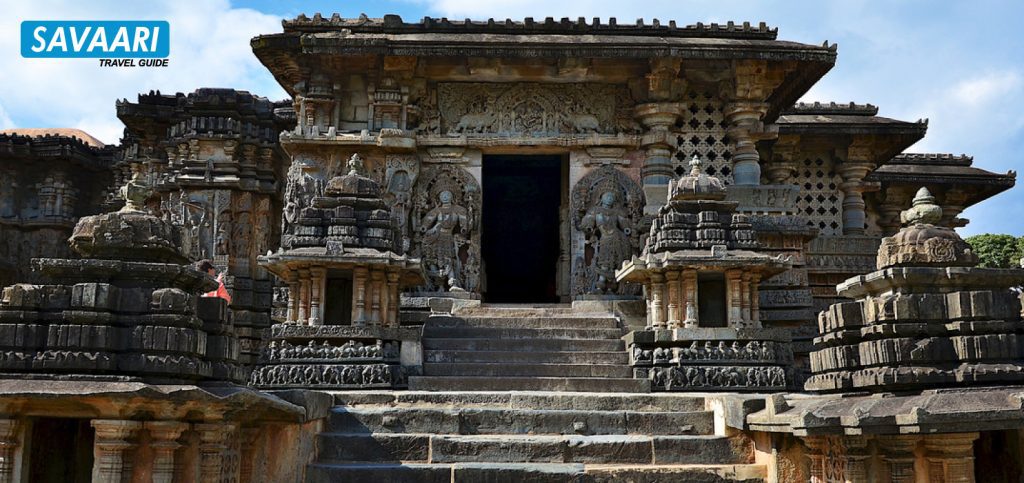Located in the northeastern Indian state of Sikkim, Khangchendzonga National Park (also spelled Kanchenjunga) is famous for its stunning beauty and rich biodiversity. Home to the third-highest peak in the world, Mount Kanchenjunga, the park is a UNESCO World Heritage Site and a top attraction for nature lovers, adventure seekers, and wildlife enthusiasts.
From exhilarating treks and nature walks to exploring ancient monasteries, Khangchendzonga National Park offers a wide range of activities for all kinds of travelers. Read this guide to learn the best things to do in Khangchendzonga and make your trip memorable. For a comfortable ride to the park, you can book a car rental in Guwahati with Savaari and travel in chauffeur-driven cabs.

Table of Contents
- About Khangchendzonga National Park
- Things To Do in Khangchendzonga National Park
- How to Plan a Trip to Khangchendzonga National Park?
- Hotels and Resorts in Khangchendzonga National Park
- Best Road Trips from Khangchendzonga National Park
- Useful Links
About Khangchendzonga National Park
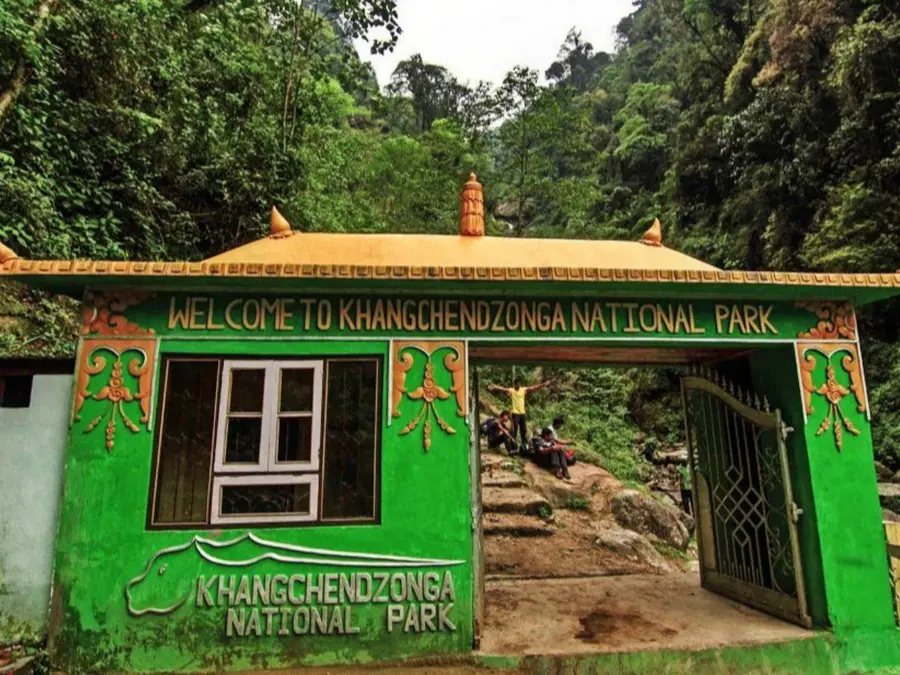
An interesting fact about Khangchendzonga National Park is that it covers an area of 1,784 square kilometers. This protected area offers a pristine natural environment. The park is renowned for its towering peaks, including Mount Kanchenjunga, green valleys, beautiful glaciers, and diverse wildlife. Visitors can immerse themselves in the park’s serene beauty, experience its unique cultural heritage, and enjoy a variety of outdoor activities.
History of Khangchendzonga National Park
Established in 1977, Khangchendzonga National Park protects the region’s unique flora, fauna, and natural beauty. The park derives its name from Mount Kanchenjunga, which means “The Five Treasures of Snows,” referring to its five summits. In 2016, the park was inscribed as a UNESCO World Heritage Site, recognizing its exceptional natural and cultural significance.
Khangchendzonga National Park: Wildlife and Forest
The park’s diverse ecosystems, ranging from subtropical forests to alpine meadows, support a wide range of species.
Flora in Khangchendzonga National Park

The park’s vegetation varies with altitude, featuring tropical broadleaf forests, temperate forests, subalpine coniferous forests, and alpine meadows. Some notable plant species include:
- Rhododendrons
- Orchids
- Blue poppies
- Primulas
- Bamboo
Fauna in Khangchendzonga National Park

Khangchendzonga National Park hosts several rare and endangered species. Some of the notable animals include:
- Snow Leopard
- Red Panda
- Himalayan Black Bear
- Musk Deer
- Himalayan Tahr
- Tibetan Wolf
- Various bird species like Blood Pheasant, Himalayan Monal, and Satyr Tragopan
Lesser-Known Facts about Khangchendzonga National Park
- The park is part of the Sacred Himalayan region and is important to the indigenous Lepcha and Bhutia communities.
- Khangchendzonga National Park is one of the few places in the world where the elusive Snow Leopard can be found.
- The park contains several glacial lakes, including the beautiful Khecheopalri Lake, which is considered sacred.
Reasons to Visit Khangchendzonga National Park
- The park’s breathtaking beauty, including snow-capped peaks, glaciers, and dense forests, offers stunning views and photography opportunities.
- The park is an adventurer’s paradise, and you can indulge in any adventurous activity, from trekking and mountaineering to camping and wildlife spotting.
- Visitors can explore the rich cultural heritage of the local communities, visit ancient monasteries, and participate in traditional festivals.
- The park’s rich biodiversity, including rare and endangered species, makes it a must-visit for nature and wildlife enthusiasts.
Things to Do in Khangchendzonga National Park
There are various things to do in Khangchendzonga National Park:
Trekking and Hiking
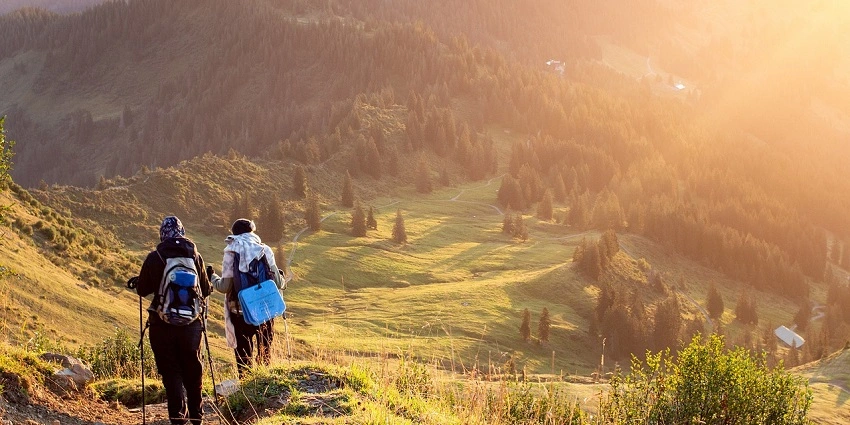
Source: Tripxl
Trekking is one of the most popular. The park offers several trekking routes, each offering unique experiences and stunning views.
- Goechala Trek: This is the most famous trek in the park. It offers close-up views of Mount Kanchenjunga and passes through beautiful spots, dense forests, and high-altitude meadows.
- Duration: 10-12 days
- Difficulty: Moderate to Challenging
- Dzongri Trek: A shorter alternative to the Goechala Trek, the Dzongri Trek offers spectacular views of the Kanchenjunga range.
- Duration: 5-6 days
- Difficulty: Moderate
- Green Lake Trek: This trek takes you to Green Lake’s base camp, offering breathtaking views of the mountains and glaciers.
- Duration: 10-12 days
- Difficulty: Challenging
Wildlife Safaris
Exploring the park’s wildlife is another exciting activity. While jeep safaris are not available, guided nature walks and hikes are some of the best things to do here, as they provide opportunities to spot various animals and birds.
Visit Monasteries

The park and its surroundings are dotted with ancient monasteries that offer a glimpse into the region’s spiritual and cultural heritage.
- Dubdi Monastery: Dubdi Monastery, one of Sikkim’s oldest, is located near Yuksom. It offers a peaceful atmosphere and beautiful views, making it a special place for spiritual seekers and tourists alike.
- Pemayangtse Monastery: This monastery in Pelling is known for its beautiful architecture and peaceful environment. It’s a significant spiritual site that attracts many visitors who appreciate its serene and historic charm.
- Tashiding Monastery: Situated near Yuksom, this is revered as one of the holiest monasteries in Sikkim. It serves as an important spiritual site, attracting visitors seeking peace and connection to Tibetan Buddhism.
Exploring Glacial Lakes

The park has many glacial lakes which are very beautiful and hold a religious significance as well. They captivate visitors with their breathtaking views and are revered for their spiritual importance. The Khecheopalri Lake is a sacred one revered by both Buddhists and Hindus, known for its tranquility and scenic beauty.
Photography
The park’s stunning beauty, diverse wildlife, and vibrant flora provide endless opportunities for photography. Whether you’re a professional or an amateur photographer, you’ll find plenty of subjects to capture.
Visit Waterfalls
The park and its surroundings are home to several picturesque waterfalls. Some of the notable waterfalls include:
- Kanchenjunga Waterfall: Located near Pelling, this waterfall is a popular tourist spot.
- Bakthang Waterfall: Located near Gangtok, it is known for its scenic beauty.
Things to Do Around Khangchendzonga National Park
Some of the places to visit in the park and around it are:
Dubdi Monastery
Dubdi Monastery, also known as Yuksom Monastery, is one of the oldest monasteries in Sikkim, India. Established in 1701, it is located on a hill, about an hour’s walk from Yuksom, and provides beautiful views and a calm atmosphere. The monastery features traditional Tibetan architecture, with beautiful murals and statues. Surrounded by lush greenery, it offers a serene and peaceful environment for visitors.
- Timings: 7:00 AM–4:00 PM
- Entry Fees: Nil
- Open Days: Everyday
The Norbugang Coronation Throne

The Norbugang Coronation Throne is a significant historical site in Yuksom, Sikkim. It marks the spot where the first king of Sikkim, Phuntsog Namgyal, was crowned in 1642. The site includes a throne, chortens (stupas), and a prayer hall. Surrounded by ancient trees and a tranquil atmosphere, it is a place of great cultural and historical importance.
- Timings: 9:00 AM–5:00 PM
- Entry Fees: Nil
- Open Days: Everyday
Kartok Lake
Kartok Lake is a beautiful and serene lake located in Yuksom, Sikkim. Named after the nearby Kartok Monastery, the lake is surrounded by lush greenery and offers stunning reflections of the surrounding mountains. It is a popular spot for relaxation and nature walks, providing a peaceful escape from busy life.
- Timings: Open 24 hours
- Entry Fees: Nil
- Open Days: Everyday
MG Marg
MG Marg in Gangtok, Sikkim, is a bustling street known for its vibrant shopping and dining scene. This pedestrian-only area is lined with various shops, cafes, and restaurants, offering a mix of local and international products and cuisines. It’s a perfect spot to enjoy a leisurely stroll, shop for souvenirs, and savor delicious food.
- Timings: Open 24 hours
- Entry Fees: Nil
- Open Days: Everyday
Enchey Monastery

Enchey Monastery, located in Gangtok, Sikkim, is a serene Buddhist monastery founded in 1909. It is perched on a hill, offering panoramic views of the surrounding mountains. The monastery is known for its beautiful architecture, colorful prayer flags, and vibrant annual festivals, making it a spiritual and cultural landmark.
- Timings: 9:00 AM–5:00 PM
- Entry Fees: Nil
- Open Days: Everyday
Rumtek Monastery
Rumtek Monastery, located near Gangtok, Sikkim, is one of the largest and most important monasteries in India. Built in the 16th century, it serves as the seat of the Karma Kagyu lineage. The monastery complex includes a Golden Stupa, prayer halls, and beautiful murals, attracting visitors and devotees worldwide.
- Timings: 6:00 AM–6:00 PM
- Entry Fees: INR 10
- Open Days: Everyday
Buddha Park
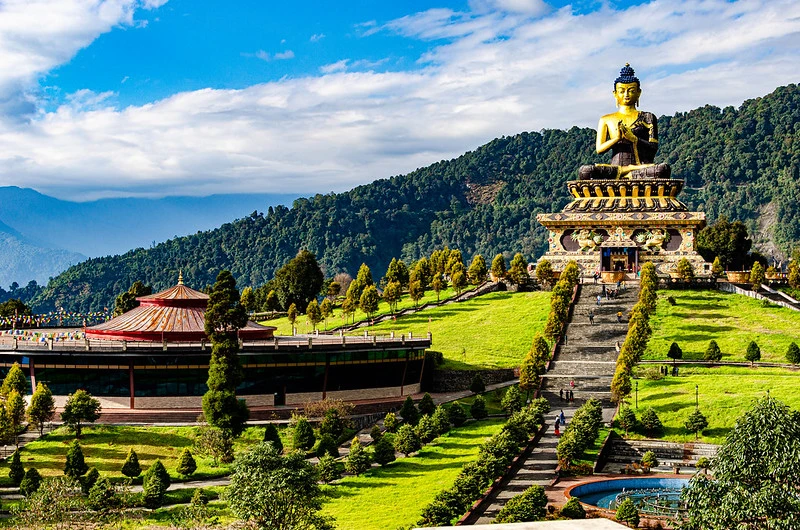
Buddha Park, also known as Tathagata Tsal, is a serene park located in Ravangla, Sikkim. It features a majestic 130-foot Buddha statue surrounded by beautiful gardens and prayer flags. The park offers panoramic views of the Himalayas and provides a peaceful environment for meditation and relaxation. It’s a popular spot for both tourists and pilgrims.
- Timings: 9:00 AM–6:00 PM
- Entry Fees: INR 50
- Open Days: Everyday
Ralang Monastery
Ralang Monastery, situated near Ravangla in Sikkim, is an important Buddhist monastery belonging to the Kagyud sect. This monastery was established in 1995 and is known for its vibrant annual festivals and intricate murals. The monastery’s peaceful surroundings and spiritual ambiance make it a significant site for meditation and learning about Tibetan Buddhism.
- Timings: 8:00 AM–5:00 PM
- Entry Fees: Nil
- Open Days: Everyday
Temi Tea Garden
Temi Tea Garden is the only tea estate in Sikkim, located in the South Sikkim district. Spanning over rolling hills, this garden is known for producing high-quality organic tea. Visitors can tour the tea plantation, learn about the tea-making process, and enjoy the scenic beauty of the surrounding mountains.
- Timings: 9:00 AM–5:00 PM
- Entry Fees: Nil
- Open Days: All days except Sunday
How to Plan a Trip to Khangchendzonga National Park
To plan a trip to Khangchendzonga National Park, visit between March and May or September and November for the best weather. Book your accommodations in nearby towns like Gangtok, Pelling, or Yuksom in advance. Contact reputable tour operators to arrange guided treks and secure the necessary permits.
Pack essentials like binoculars, comfortable clothing, sturdy shoes, and insect repellent. The nearest airport is Bagdogra, and the closest major train station is New Jalpaiguri. Plan your travel arrangements early for a smooth trip.
How to Reach Khangchendzonga National Park
Here’s how you can reach Khangchendzonga National Park using different modes of transportation:
By Train
The nearest train station to Khangchendzonga National Park is New Jalpaiguri, about 110 kilometers away. This station is well-connected to major cities like Kolkata, Delhi, and Guwahati. You can also book a Savaari car rental in New Jalpaiguri to the park for a comfortable journey.
By Road
The park is accessible by road from several towns and cities in Sikkim. The main entry points are from Gangtok and Pelling. State and private buses, as well as taxis, regularly operate in these towns. For a convenient travel experience, use the Savaari cab booking app, book a cab service in Gangtok to the park, and travel at your own pace.
By Flight
The nearest airport to Khangchendzonga National Park is Bagdogra Airport, about 109 kilometers away. But the nearest international airport is Netaji Subhash Chandra Bose International Airport, and you can hire an airport taxi in Kolkata with Savaari using our car rental app and reach the park or your hotel in Gangtok or Pelling. Alternatively, you can take a bus from Siliguri Bus Terminal, which is close to Bagdogra, and then continue your journey to the park by road.
Best Time to Visit Khangchendzonga National Park
The best time to visit Khangchendzonga National Park is from April to June and from September to November. During these months, the weather is pleasant, and the park’s natural beauty is at its peak.
The monsoon season (July to September) brings heavy rainfall, making trekking and other outdoor activities difficult. The winter season (December to March) can be extremely cold, with heavy snowfall at higher altitudes.
Travel Tips for Visiting Khangchendzonga National Park
Keep in mind the following travel tips for visiting Khangchendzonga National Park:
- Carry Valid ID Proof: You must show valid ID proof to obtain the entry permit for the park.
- Respect Local Culture: The park and its surroundings are home to indigenous communities. Respect their culture and traditions.
- Stay on Trails: To protect the park’s ecosystems, always stay on designated trails and follow the park rules.
- Avoid Single-Use Plastics: Help keep the park clean by avoiding single-use plastics and disposing of your waste properly.
- Be Prepared for Altitude: Some parts of the park are at high altitudes. Take time to acclimatize and be aware of the symptoms of altitude sickness.
Khangchendzonga National Park Safari Timings and Entry Fee
There is no Jeep safari available in the park. If you still want to explore the whole park, there is an option of a walking safari. The entry fee for Indian nationals is INR 200 per person per day. For foreign nationals, the fee is INR 400 per person per day. The park is open from 6:00 AM to 5:00 PM. However, entry is allowed only during daylight hours.
Things to Do in Khangchendzonga National Park for Free
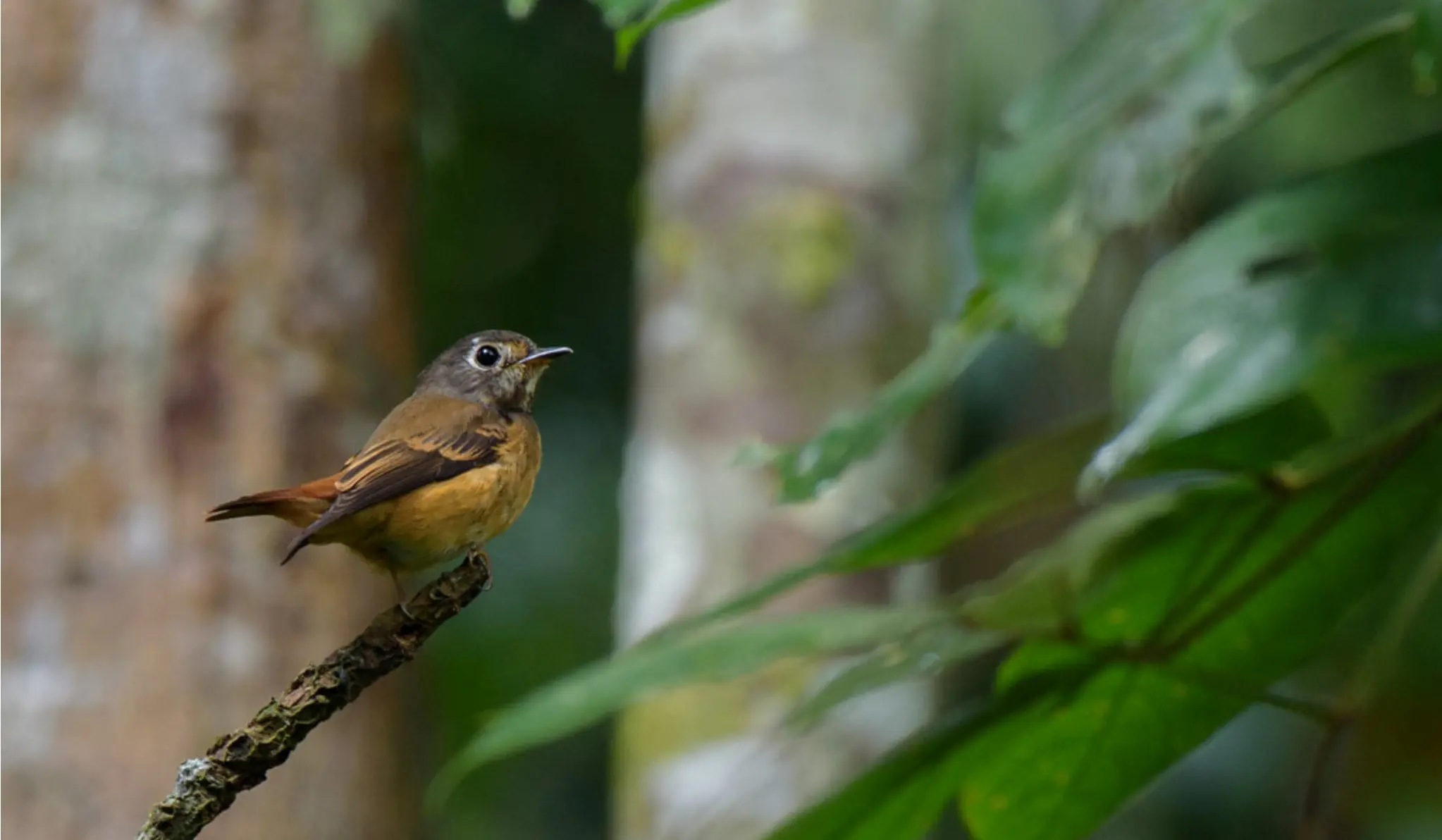
Some of the best things to do in Khangchendzonga National Park for free are:
- Enjoy a Nature Walk
Take a peaceful walk through the park’s green forests while listening to the chirping birds and the rustling leaves. You might spot some unique plants and colorful butterflies. Walking in the fresh air and beautiful scenery is refreshing and free for everyone.
- Visit the Sacred Lake
Explore the holy lake, Khecheopalri, which is surrounded by thick forests and considered sacred by locals. Enjoy the calm and peaceful atmosphere. You can sit by the lake, make a wish, or simply relax and take in the stunning natural beauty for free.
- Bird Watching
Bring your binoculars and enjoy bird watching in Khangchendzonga National Park, one of the top birdwatcher’s paradise in India. The park is home to over 300 species of birds, including many rare and migratory species. Look out for vibrant pheasants, eagles, and other fascinating birds. Some popular bird-watching spots include Yuksom and Pelling.
Hotels and Resorts in Khangchendzonga National Park
Here’s a list of hotels and resorts in and around Khangchendzonga National Park to help you plan your visit, whether you’re traveling during the peak season or off-season.
| Hotel Name | Address | Phone Number |
| The Elgin Mount Pandim | Monastery Road, Pemayangtse, Pelling, Sikkim 737113 | +9184201 99171 |
| Cherry Village Homestay Resort | Pelling-Rimbi Road, Pelling, Sikkim 737113 | +9197332 35441 |
| The Chumbi Mountain Retreat | Naku-Chumbong, Pelling, Sikkim 737113 | +9199331 26619 |
| Summit Tashigang Resort | Yangtey, Pelling, Sikkim 737111 | +9179083 93670 |
Best Road Trips from Khangchendzonga National Park
Here are some of the highest-rated road trips from Khangchendzonga National Park. Each trip offers unique attractions and beautiful views, making it a great addition to your adventure in the region.
| Destination | Distance by Road (approx.) | Travel Time (hours) (approx.) | Price |
| Gangtok to Guwahati | 547 km | 19 | INR 19,481 |
| Gangtok to Pelling | 108 km | 4 | INR 8571 |
| Gangtok to Kolkata | 710 km | 16 | INR 18,995 |
| Gangtok to Jalpaiguri | 174 km | 6 | INR 3464 |
| Gangtok to Bagdogra | 136 km | 5 | INR 4250 |
The national park offers a perfect blend of natural beauty, adventure, and cultural heritage. Whether you’re trekking, exploring ancient monasteries, or spotting rare wildlife, you’ll find plenty of things to do and see in this beautiful park. Download the Savaari car rental app and book a chauffeur-driven car rental from Gangtok to travel to Khangchendzonga National Park conveniently and stress-free.
Useful Links
Last Updated on December 11, 2024 by V Subhadra





